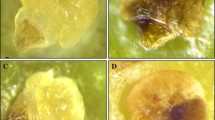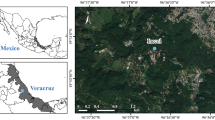Abstract
When specialists and generalists compete for a limited resource, specialists are more constrained because they are less likely to find an alternative resource. In parasitoids with overlapping host ranges, asymmetric competition should therefore exist where specialists are more likely to win the host in a contest. Competition between parasitoids has been studied mostly in hymenopterans. In hymenopteran parasitoid wasps, females must reach the host to lay their eggs and can thus strongly influence the outcome of competition between future offspring by killing eggs or larvae of competitors. We studied competition between the free-ranging larvae of two sympatric coleopteran parasitoid rove beetles (one specialist, Aleochara bilineata and a generalist, Aleochara bipustulata) with overlapping host ranges competing in agricultural fields for pupae of the cabbage root fly. In these species, females lay their eggs in the soil, then first instars find the host where they will develop as solitary parasitoids and deal with potential competitors. Because adult longevity and fecundity favour the generalist, we postulated that first instars of the specialist would be superior larval competitors. Accordingly, we studied the outcome of encounters between first instars of the two species provided with a single host. Irrespective of its release prior to or simultaneously with its generalist competitor, the larva of the specialist most often won. Moreover, specialist larvae still won half of the encounters when generalist larvae were given a 24-h advantage. This might explain the coexistence of the two species in the field.


Similar content being viewed by others
References
Amarasekare P (2000) Coexistence of competing parasitoids on a patchily distributed host: local vs. spatial mechanisms. Ecology 81(5):1286–1296
Boivin G, van Baaren J (2000) The role of larval aggression and mobility in the transition between solitary and gregarious development in parasitoid wasps. Ecol Lett 3(6):469–474
Brodeur J, Boivin G (2004) Functional ecology of immature parasitoids. Annu Rev Entomol 49(1):27–49
Brown WL, Wilson EO (1956) Character displacement. Syst Zool 5(2):49–64
Carton Y, Bouletreau M, van Alphen JJM, van Lenteren JC (1986) The Drosophila parasitic wasps. In: Ashburner M, Thompson J (eds) The genetics and biology of Drosophila. Academic Press, New York, pp 347–394
Chow FJ, Mackauer M (1984) Inter-and intraspecific larval competition in Aphidius smithi and Praon pequodorum (Hymenoptera: Aphidiidae). Can Entomol 116(08):1097–1107
Colhoun J (1953) Observations on the incidence of club root disease of Brassicae in limed soils in relation to temperature. Ann Appl Biol 40(4):639–644
Dayan T, Simberloff D (2005) Ecological and community-wide character displacement: the next generation. Ecol Lett 8(8):875–894
De Moraes CM, Cortesero AM, Stapel JO, Lewis WJ (1999) Intrinsic and extrinsic competitive interactions between two larval parasitoids of Heliothis virescens. Ecol Entomol 24:402–410
DeBach P, Sisojević P (1960) Some effects of temperature and competition on the distribution and relative abundance of Aphytis lingnanensis and A. chrysomphali (Hymenoptera: Aphelinidae). Ecol 41(1):153–160
Eggleton P, Gaston KJ (1990) “ Parasitoid” species and assemblages: convenient definitions or misleading compromises? Oikos 59:417–421
Elzinga JA, Zwakhals K, Harvey JA, Biere A (2007) The parasitoid complex associated with the herbivore Hadena bicruris (Lepidoptera: Noctuidae) on Silene latifolia (Caryophyllaceae) in the Netherlands. J Nat Hist 41(1–4):101–123
Feener DH, Brown BV (1997) Diptera as parasitoids. Annu Rev Entomol 42(1):73–97
Fisher RC (1961) A study in insect multiparasitism. II. The mechanism and control of competition for possession of the host. J Exp Biol 38(3):605–629
Force DC (1972) R- and K-strategists in endemic host-parasitoid communities. Bull Entomol Soc Am 18:135–137
Force DC (1974) Ecology of insect host-parasitoid communities. Science 184(4137):624–632
Fournet S (2000) Ecologie comportementale des adultes et des larves de deux coléoptères Staphylinidae, parasitoïdes de la mouche du chou. PhD thesis, University of Rennes 1
Fournet S, Renoult L, Nenon JP, Brunel E (1999) Super- et multiparasitisme chez les Aleochara (Coleoptera: Staphylinidae) inféodés à la mouche du chou Delia radicum L.(Diptera: Anthomyiidae). Ann Soc Entomol Fr 35:384–389 (Société entomologique de France)
Fournet S, Stapel JO, Kacem N, Nenon JP, Brunel E (2000) Life history comparison between two competitive Aleochara species in the cabbage root fly, Delia radicum: implications for their use in biological control. Entomol Exp Appl 96(3):205–211
Fuldner D (1960) Beitrage zur morphologie und biologie von Aleochara bilineata Gyll. und A. bipustulata L. (Coleoptera: Staphylinidae). Z Morph Okol Tiere 49:312–386
Gause GF (1934) Experimental analysis of Vito Volterra’s mathematical theory of the struggle for existence. Science 79(2036):16–17
Godfray HCJ (1994) Parasitoids: behavioral and evolutionary ecology. Princeton University Press, New Jersey
Goubault M, Plantegenest M, Poinsot D, Cortesero AM (2003) Effect of expected offspring survival probability on host selection in a solitary parasitoid. Entomol Exp Appl 109:123–131
Hardy ICW, Goubault M, Batchelor TP (2013) Hymenopteran contests and agonistic behaviour. In: Hardy ICW, Briffa M (eds) Animal contests. Cambridge University Press, Cambridge, pp 147–177
Harvey JA, Strand MR (2003) Sexual size and development time dimorphism in a parasitoid wasp: an exception to the rule? Eur J Entomol 100:485–492
Harvey JA, Harvey IF, Thompson DJ (1993) The effect of superparasitism on development of the solitary parasitoid wasp, Venturia canescens (Hymenoptera, Ichneumonidae). Ecol Entomol 18:203–208
Harvey JA, Gols R, Strand MR (2009) Intrinsic competition and its effects on the survival and development of three species of endoparasitoid wasps. Entomol Exp Appl 130:238–248
Harvey JA, Gumovsky A, Gols R (2012) Effect of host-cocoon mass on adult size in the secondary hyperparasitoid wasp, Pteromalus semotus (Hymenoptera: Pteromalidae). Insect Sci 19(3):383–390
Harvey JA, Poelman EH, Tanaka T (2013) Intrinsic inter-and intraspecific competition in parasitoid wasps. Annu Rev Entomol 58:333–351
Hassell MP, May RM (1986) Generalist and specialist natural enemies in insect predator-prey interactions. J Anim Ecol 55:923–940
Hubbell SP (2005) Neutral theory in community ecology and the hypothesis of functional equivalence. Funct Ecol 19(1):166–172
Ives AR (1988) Aggregation and the coexistence of competitors. Ann Zool Fenn 25(1):75–88
Iwao K, Ohsaki N (1996) Inter-and intraspecific interactions among larvae of specialist and generalist parasitoids. Res Popul Ecol 38(2):265–273
Jaloux B, Sanon A, Huignard J, Monge JP (2004) Interspecific relationships between the solitary ectoparasitoid, Eupelmus vuilleti (Crw.) (Eupelmidae), and its sympatric species, Dinarmus basalis (Rond.) (Pteromalidae), in the presence of their host, Callosobruchus maculatus Pic (Coleoptera Bruchidae). J Insect Behav 17(6):793–808
Josso C (2012) Écologie des interactions entre la mouche du chou Delia radicum et ses ennemis naturels: de la parcelle au paysage. Doctoral dissertation, Rennes 1
Laing JE, Corrigan JE (1987) Intrinsic competition between the gregarious parasite, Cotesia glomeratus and the solitary parasite. Cotesia rubecula [Hymenoptera: Braconidae] for their host. Artogeia rapae [Lepidoptera: Pieridae]. Entomophaga 32(5):493–501
MacArthur RH (1972) Geographical ecology: patterns in the distribution of species. Harper and Rowe, New York
Mackauer M (1990) Host discrimination and larval competition in solitary endoparasitoids. In: Mackauer M, Ehler LE, Roland J (eds) Critical issues in biological control
Maus CH, Mittmann B, Peschke K (1998) Host records of parasitoid Aleochara Gravenhorst species (Coleoptera, Staphylinidae) attacking puparia of cyclorrhapheous Diptera. Dtsch Entomol Z 45(2):231–254
Pérez-Lachaud G, Hardy ICW, Lachaud JP (2002) Insect gladiators: competitive interactions between three species of bethylid wasps attacking the coffee berry borer, Hypothenemus hampei (Coleoptera: Scolytidae). Biol Control 25(3):231–238
Petersen G, Hardy ICW (1996) The importance of being larger: parasitoid intruder–owner contests and their implications for clutch size. Anim Behav 51(6):1363–1373
R Core Team (2014) R: a language and environment for statistical computing. R Foundation for Statistical Computing, Vienna. http://www.R-project.org. Accessed 2 June 2014
Reader PM, Jones TH (1990) Interactions between an eucoilid [Hymenoptera] and a staphylinid [Coleoptera] parasitoid of the cabbage root fly. Entomophaga 35(2):241–246
Royer L, Lannic J, Nénon JP, Boivin G (1998) Response of first-instar Aleochara bilineata larvae to the puparium morphology of its dipteran host. Entomol Exp Appl 87(2):217–220
Royer L, Fournet S, Brunel E, Boivin G (1999) Intra-and interspecific host discrimination by host-seeking larvae of coleopteran parasitoids. Oecologia 118(1):59–68
Schmid-Hempel R, Schmid-Hempel P (1996) Larval development of two parasitic flies (Conopidae) in the common host Bombus pascuorum. Ecol Entomol 21:63–70
Schoener TW (1983) Field experiments on interspecific competition. Am Nat 122:240–285
Shi ZH, Li QB, Li X (2004) Interspecific competition between Diadegma semiclausum Hellen (Hym., Ichneumonidae) and Cotesia plutellae (Kurdjumov) (Hym., Braconidae) in parasitizing Plutella xylostella (L.) (Lep., Plutellidea). J Appl Entomol 128(6):437–444
Sorribas J, Rodríguez R, Garcia-Mari F (2010) Parasitoid competitive displacement and coexistence in citrus agroecosystems: linking species distribution with climate. Ecol Appl 20(4):1101–1113
Stilmant D, van Bellinghen C, Hance T, Boivin G (2008) Host specialization in habitat specialists and generalists. Oecologia 156(4):905–912
Strickler K (1979) Specialization and foraging efficiency of solitary bees. Ecology 60:998–1009
Tian SP, Zhang JH, Yan YH, Wang CZ (2008) Interspecific competition between the ichneumonid Campoletis chlorideae and the braconid Microplitis mediator in their host Helicoverpa armigera. Entomol Exp Appl 127(1):10–19
Tillman PG, Powell JE (1992) Intraspecific host discrimination and larval competition in Microplitis croceipes, Microplitis demolitor, Cotesia kazak (HYM.: Braconidae) and Hyposoter didymator HYM: Ichneumonidae), parasitoids of Heliothis virescens (LEP.: Noctuidae). Entomophaga 37(3):429–437
Tilman D (2000) Causes, consequences and ethics of biodiversity. Nature 405(6783):208–211
Tunca H, Kılınçer N (2009) Effect of superparasitism on the development of the solitary parasitoid Chelonus oculator Panzer (Hymenoptera: Braconidae). Turk J Agric For 33(5):463–468
van Alphen JJM, Visser ME (1990) Superparasitism as an adaptive strategy for insect parasitoids. Annu Rev Entomol 35(1):59–79
van Keymeulen M, Hertveldt L, Pelerents C (1981) Methods for improving both the quantitative and qualitative aspects of rearing Delia brassicae for sterile release programmes. Entomol Exp Appl 30(3):231–240
Vázquez DP, Melián CJ, Williams NM, Blüthgen N, Krasnov BR, Poulin R (2007) Species abundance and asymmetric interaction strength in ecological networks. Oikos 116(7):1120–1127
Yamauchi K, Asano Y, Lautenschläger B, Trindl A, Heinze J (2005) A new type of male dimorphism with ergatoid and short-winged males in Cardiocondyla cf. kagutsuchi. Insectes Soc 52(3):274–281
Acknowledgments
The authors would like to thank V. Chaminade for providing pupae and for rearing maintenance.
Author contribution statement
M. B., D. P. and A. M. C. conceived and designed the experiments. M. B. performed the experiments. M. B. and Y. O. analyzed the data. M. B. wrote the manuscript. D. P., A. M. C. and Y. O. provided editorial advice.
Author information
Authors and Affiliations
Corresponding author
Additional information
Communicated by Thomas S. Hoffmeister.
Rights and permissions
About this article
Cite this article
Bili, M., Cortesero, A.M., Outreman, Y. et al. Host specialisation and competition asymmetry in coleopteran parasitoids. Oecologia 182, 111–118 (2016). https://doi.org/10.1007/s00442-016-3639-9
Received:
Accepted:
Published:
Issue Date:
DOI: https://doi.org/10.1007/s00442-016-3639-9




